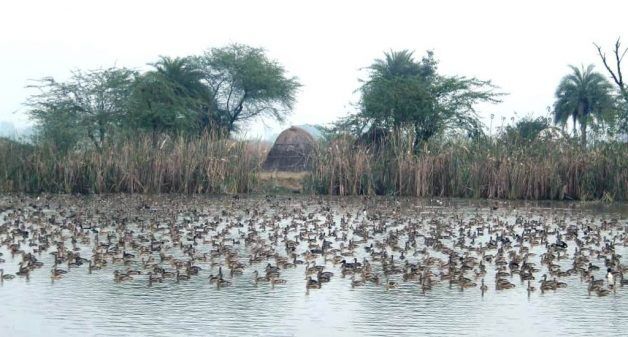
Small wetlands are being neglected
While larger wetlands are being protected and restored, smaller ones of vital importance to villagers are being ignored at best, encroached upon at worst.

While larger wetlands are being protected and restored, smaller ones of vital importance to villagers are being ignored at best, encroached upon at worst.
Wetlands teeming with local and migratory birds are a nature lovers’ wonderland. Their rich biodiversity also brings many positive environmental benefits to surrounding areas.
Considering their value for ecosystem services, it is little wonder the UNESCO “Convention on Wetlands,” also known as the Ramsar Convention, helps ensure wetlands around the world are protected.
Uttar Pradesh is promoting the conservation of its eight Ramsar sites with efforts to get Haiderpur, a wetland fed by River Ganga and its tributary Solani, also named a Ramsar site.
But while the Haiderpur wetland is important, there are many smaller wetlands facing neglect and in desperate need of restoration to bring back rich biodiversity to struggling villages.
Identifying wetlands
India’s Ministry of Environment, Forest and Climate Change (MoEFCC) has agreed that once wetlands are identified, their features, zones of influence and threats need to be documented.
Uttar Pradesh is rich in these wetlands, which cover 12.4 lakh hectares of the state, according to the National Wetland Atlas. Not surprisingly, the government has identified an astonishing 1.23 lakh wetlands in need of protection.
Vinay Kumar Upadhyay, a retired officer working as a coordinator in the UP State Wetlands Authority, said this formal identification process is vital.

“The state authority – mandated to identify and conserve wetlands – documents them and (sends the documents) to the technical committee. Of the 180 wetlands we chose, 139 were taken to the technical committee and we are presently working on 50 wetlands,” said Upadhyay.
A neglected wetland
However, many wetlands do not get such attention.
Like the Nagla Maya village wetland in the Etawah district of UP. It is only 1.6 hectares, yet it attracted many migratory birds in winter. A decade ago, it was expanded under the Mahatma Gandhi National Rural Employment Guarantee Scheme (MGNREGS), a scheme that offers livelihood security in the form of unskilled labour work to villagers for a minimum of 100 days a year.
Even though villagers have tried to conserve the wetland, they need more help clearing it of unwanted vegetation in order for it to be fully restored.
Atul Kant Shukla, divisional forest officer of Etawah, said that work on deepening the Nagla Maya wetland and creating a boundary will start soon.
“If we don’t conserve wetlands, people will encroach upon them. There are funds available through the MGNREGS that can be used for the work,” he said.

Etawah-based Rajeev Chauhan, who works on Sarus crane conservation, believes that locals chase away poachers and monitor the birds. But it is not enough.
“We don’t allow anyone to kill birds or catch fish. As the wetland hasn’t been restored, the avian population has declined. Last year, only a few birds arrived. People have built houses on the water body,” said resident Satram Singh.
Encroachment is the biggest problem. Sometimes it is for the development of buildings, but it can also be for farming. When the wetlands dry up, many farmers cultivate their crops on the dry bed, destroying the eco-balance of the wetland and not allowing it to thrive.
A villager, who did not want to be named, said that influential people were preventing the restoration of the local wetland and that despite the villagers appealing for help, authorities have done nothing.
Restored wetlands
Ironically, while the Nagla Maya wetland is in bad shape, even smaller Nagla Jhadu wetland – just spread over a hectare in the adjoining Mainpuri district – has been restored by employing 2,645 villagers under MGNREGS.
Besides deepening the wetland, mounds within the area were also created to attract birds.
“Work started last December and was completed in February this year. Farmers had encroached the wetland for wheat cultivation. But now it’s been deepened,” said Prem Chandra Ram, deputy commissioner, MGNREGS.
Apart from Nagla Jhadu, 10 other wetlands also have been restored.

On bigger wetlands, watchtowers have been built to allow people to watch the birds. The Sarus Circuit Project is a group promoting conservational tourism, to create awareness about the graceful Sarus crane, which is under threat as its wetland habitat diminishes.
Involving communities for restoration
In 2019 the Ministry of Environment, Forest and Climate Change (MoEFCC) initiated a programme to create integrated management plans for 1,000 wetlands in India.
To boost conservation, district wetland committees are creating management plans for wetlands measuring over 2.25 hectares, though smaller ones need restoring too.
MoEFCC’s wetlands division aims to protect wetlands by involving communities.
Suresh Babu, director of river basins and water policy at WWF India, explained that under community-led conservation, locals play an active role in identifying wetlands and restoring them. “Known as wetland mitras, they volunteer for wetland conservation,” Babu added.
Babu said a decentralised model is needed for conservation in India, with its 755,000 wetlands spread across 670,000 villages.
Healthy wetlands provide enabling conditions for flora and fauna. For instance, the Upper Ganga Ramsar site is home to the Ganges river dolphin, gharials, otters, turtles and 140 fish species.
“Wetlands must be used in a sustainable way to support agriculture, fisheries and irrigation,” said Upadhyay. However, staff shortage in the state authority makes the task difficult.
Etawah-based retired forest ranger Ramesh Chandra feels the government needs to step up and offer more help to those trying to protect smaller wetlands.
“Though residents of Nagla Maya protect the wetland, they need governmental support,” he said.
Deepanwita Gita Niyogi is a Delhi-based journalist.